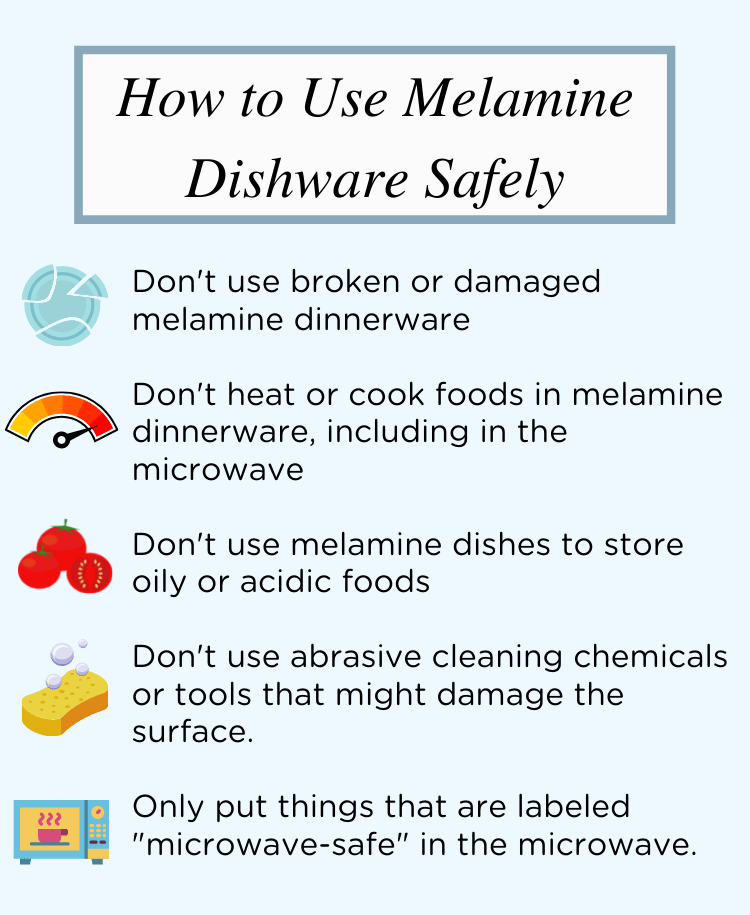
You’ve probably used melamine dinnerware before, whether you realize it or not. It’s inexpensive, lightweight, durable, and available in nearly every color and shape imaginable. Consequently, home cooks worldwide have been using melamine dishes since their 1950s debut!
However, when this dishware first became available, microwaves were still a thing of the distant future. Even in 1971, only 1% of US households owned a microwave!
So melamine was never intended to go in them. That leads us to the question: Can melamine go in the microwave? More specifically, is melamine safe in the microwave…
Though many depend on this appliance daily, you should not put melamine dishware in the microwave.
Below, we’ll review what melamine is, why it should stay out of the microwave, and how to use your melamine dishware safely.
What Is Melamine?
Melamine is a chemical compound used to produce various kitchen items, primarily dinnerware. Outside the kitchen, it’s often used in paper products or industrial coatings.
When combined with formaldehyde, melamine turns into melamine resin. Manufacturers can then heat this resin and shape it into dinnerware. This is how most melamine dishware is made today.
Melamine is durable, heat resistant, and dishwasher-safe, hence why so many kitchen products use it. It’s also lighter-weight than ceramic, yet designers can make it look just as elegant.
What Kitchen Products Are Made of Melamine?
Many plastic food containers and tableware are made with melamine. You can find melamine plates, bowls, cups, and more.
One major draw to melamine is its variety… It comes in various shapes, colors, and patterns, from simple primary-colored bowls to dinner sets with complex designs. Yet, all melamine dinnerware products are notable for their extreme durability and smooth texture.
Some bamboo products also contain melamine. You’ll find it in most bamboo plates and even cutting boards.

Is Melamine Safe?
Melamine can cause health issues at high doses, although it’s not considered acutely toxic.
The FDA has set limits on the amount of melamine considered food-safe (2500 parts per billion). Ingesting anything below this amount is safe, but higher amounts can cause melamine poisoning.
Symptoms include:
- Irritability
- Blood in the urine
- Little or no urine
- Kidney stones in infants
- High blood pressure
Despite these health risks, melamine in your dishware is not a major source of exposure.
Melamine dishes are safe at room temperature because melamine doesn’t leach into your food unless it’s heated. Even if a little bit does leach, it’s not enough to make you sick.
Here’s an example:
The FDA tested leaching by letting cold orange juice sit in a melamine cup for 15 minutes. They found the cup only leached ten parts of melamine per billion parts of juice – an amount 250x lower than the FDA deems unsafe.
However, melamine can leach into your food when heated, making it unsafe at higher temperatures.
Foods heated in melamine dishware to 160℉+ (like in a microwave) may leach melamine into your food at dangerous levels. And risk increases with long-term use and exposure. The chance of leaching grows even higher with highly acidic foods (like tomato sauce). Or when stored in melamine containers for an extended period.
For example, a 2013 study found that participants who ate hot soup from melamine bowls (compared to ceramic) had much higher melamine levels in their urine. Now, the study didn’t look at health outcomes specifically. But the authors did note that long-term melamine exposure from your dishware is likely a health concern.
Knowing these facts makes our question (is melamine microwave-safe?) easy to answer…
Can Melamine Go in Microwaves? The Verdict
Long story short: You should never put melamine in microwaves.
As mentioned above, melamine can leach out of plastics and into food at high temperatures. And this can cause health problems when you ingest large amounts.
Heating and eating food in this dishware puts you at a higher risk of ingesting unsafe melamine levels. While acidic foods are more likely to cause leaching, it’s best to avoid heating melamine altogether.
Only put cookware and kitchenware that specify “microwave-safe” in the microwave.
What Happens To Melamine Plates in the Microwave?
Not only can melamine leach into food, but it can also ruin your dishes themselves! How?
Melamine dries out at higher temperatures, so your dinnerware may break down or even crack as it heats. This breakdown also makes the leaching of toxic chemicals more likely.
Final Thoughts: Using Melamine Safely

Despite the above facts, don’t go throwing out all your melamine plates, bowls, and cups! So long as you use your melamine dinnerware properly, there’s no risk to your health.
Here’s how to safely use your melamine dinnerware:
- Never put an item in the microwave that doesn’t have a “microwave-safe” label.
- Avoid broken or damaged melamine dinnerware. It can leach chemicals into your food.
- Do not heat or cook foods in melamine dishware. This includes the microwave or oven.
- Don’t use melamine to hold deep-fried foods, hot oil, or store highly acidic foods.
- When cleaning your melamine tableware, avoid abrasives that might scratch the surface.
If you follow these restrictions, melamine dinnerware is safe. But you can always use alternatives like glass or ceramic to stay on the extra safe side!
And where can you find the cleanest, safest glass and ceramic dinnerware? Find out in our guide: Safest Dishes to Use at Home – How to Avoid Toxic Dinnerware.

Hi there! I'm Adam, author and founder of TGL. Since 2016, I've produced and sold non-toxic kitchenware throughout the US. Today, I'm using my passion and experience in sustainable product manufacturing to help families avoid unsafe reusable foodware. When I'm not writing, you'll find me hiking or camping throughout Appalachia!
Enjoyed this post? Share it with your friends!
Related Posts
FREE Guide
Non-Toxic Kitchenware Checklist
Get a step-by-step product guide with insider tips & tricks for the safest kitchen possible!





